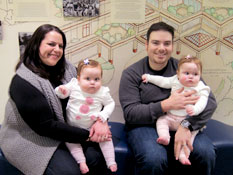Transplants for Two: Twins Get New Livers to Treat Rare Disease
Twins Sophia and Charlotte Gonzalez required numerous blood transfusions as newborns and again during their recent liver transplants. The below article is by Erin Digitale, Writer for Stanford School of Medicine’s Communications & Public Affairs Department.
In a small room at Lucile Packard Children’s Hospital, Megan and Ricky Gonzalez each held one hand of their daughter Sophia, comforting her as she recovered from a Nov. 8 liver transplant. Near Sophia’s crib, her identical twin, Charlotte, babbled happily in the girls’ double stroller. Charlotte was waiting her turn which came Nov. 27 for her own liver transplant to treat the metabolic disease that nearly killed both girls as newborns.
Sophia and Charlotte Gonzalez, now 17 months old, were born with a rare genetic disorder that inhibits the body’s ability to break down protein and some fats. They are among the only known pairs of twins with their condition, a severe form of methylmalonic acidemia that typically causes the liver and kidneys to fail by early adolescence. The disorder has the potential to cause catastrophic brain damage at any point in life.
Packard Children’s is among a handful of institutions pioneering the treatment the girls received: They received unusually early liver transplants to ward off the disease’s worst effects.
“It’s like stacking the deck in the child’s favor,” said Gregory Enns, MD, the twins’ biochemical geneticist, explaining why he advocated early transplants. Sophia and Charlotte were already pulled back from the edge of catastrophe when test results from California’s Newborn Screening Program arrived just in time to let their physicians intervene before the disease got out of control. Now, by giving the girls livers with normal metabolism, Enns hopes to avoid irreversible damage to their kidneys and brains.
* * *
When Megan and Ricky’s twins were born in September 2010, the babies seemed healthy. But after a few days in the hospital, they were lethargic, feeding poorly and losing worrisome amounts of weight. Then Sophia’s newborn screening results showed severe metabolic problems. Just in time, the San Mateo family was referred to Packard Children’s.
“Dr. Enns said if it had been another day, they might have not made it,” Megan said.
“They were already starting to slip into comas as we got to Packard,” Ricky added.
Without the results of the newborn screening tests, the girls would probably have been misdiagnosed with sepsis, received the wrong treatment and died, Enns said.
Instead, diagnostic testing at Packard Children’s state-of-the-art biochemical genetics lab confirmed that Sophia and Charlotte have an inherited defect in an enzyme that works at the crossroads of several metabolic pathways, including those that handle four of the 20 amino acid “building blocks” of protein.
The defect caused the girls’ blood methylmalonic acid levels to shoot up to several thousand times normal. Their bodies also couldn’t process ammonia, a byproduct of protein breakdown, so its blood levels spiked, too. Sky-high acid and ammonia levels can each cause severe, permanent brain damage or death. Fortunately, the biochemical genetics team at Packard Children’s lowered the girls’ levels of the toxins.
“This is a strange disease,” Enns said, likening its management to “walking a tightrope of metabolic balance.” After the first crisis was averted, the girls consumed a carefully monitored low-protein diet and took medications to lower their acid and ammonia levels. But even with expert care, anything that upset their metabolism such as a cold or other minor illness could have thrown off their fragile metabolic balance, causing catastrophic brain damage.
“These kids are ticking time bombs in many ways, especially when they get an infection,” Enns said.
The constant threat of brain damage prompted the team to consider the unusual step of putting both girls on the transplant waiting list at the same time.
“It’s controversial to transplant two siblings so close together because you’re putting family under so much stress,” said Carlos Esquivel, MD, PhD, who performed both transplant surgeries. “But on the other hand, if you don’t do that and one kid has hyperammonia and ends up with brain damage, you never forgive yourself.”
Fortunately, the Gonzalez family has strong support networks and could care for both twins during their recoveries.
The surgeries presented special challenges because the girls’ disease made their tissues fragile. The transplant team also had to be alert to the possibility that surgical stress could itself trigger a metabolic crisis. But the procedures went well, and Sophia and Charlotte have made strong recoveries.
“We’re just so thankful and grateful to the families that donated their children’s livers to my girls,” Megan said.
Although the transplants didn’t cure the girls’ disease, they greatly lowered the risk of brain-damaging metabolic crises. The transplanted livers function normally and, because ammonia is processed only in the liver, the girls are now safe from toxic ammonia spikes. Their acid levels will be significantly lower than before transplant, but still above normal, and they will have to follow restricted diets and take medication. In short, their overall prognosis is much improved.
“Early liver transplants are the best treatment we have for these children today,” Enns said. Though he cautioned that the approach is too new to be certain of its long-term benefits, he said that methylmalonic acidemia patients are “much less brittle” after transplant: “They’re not in the hospital as often, and their metabolic crises are much easier to treat.”
Sophia went home from the hospital in early December and Charlotte arrived home on Christmas morning.
Megan and Ricky are already seeing the beneficial effects of the girls’ changed metabolism, particularly in Sophia, whose recovery is a little further along. “Sophia is crawling, sitting up on her own, standing up and holding onto stuff, and doing a lot of babbling,” Megan said. “She wasn’t doing that at all before. As soon as she started feeling better at home, she started hitting all these milestones. It’s just incredible.”
This article adapted from material provided by the Stanford University School of Medicine.


